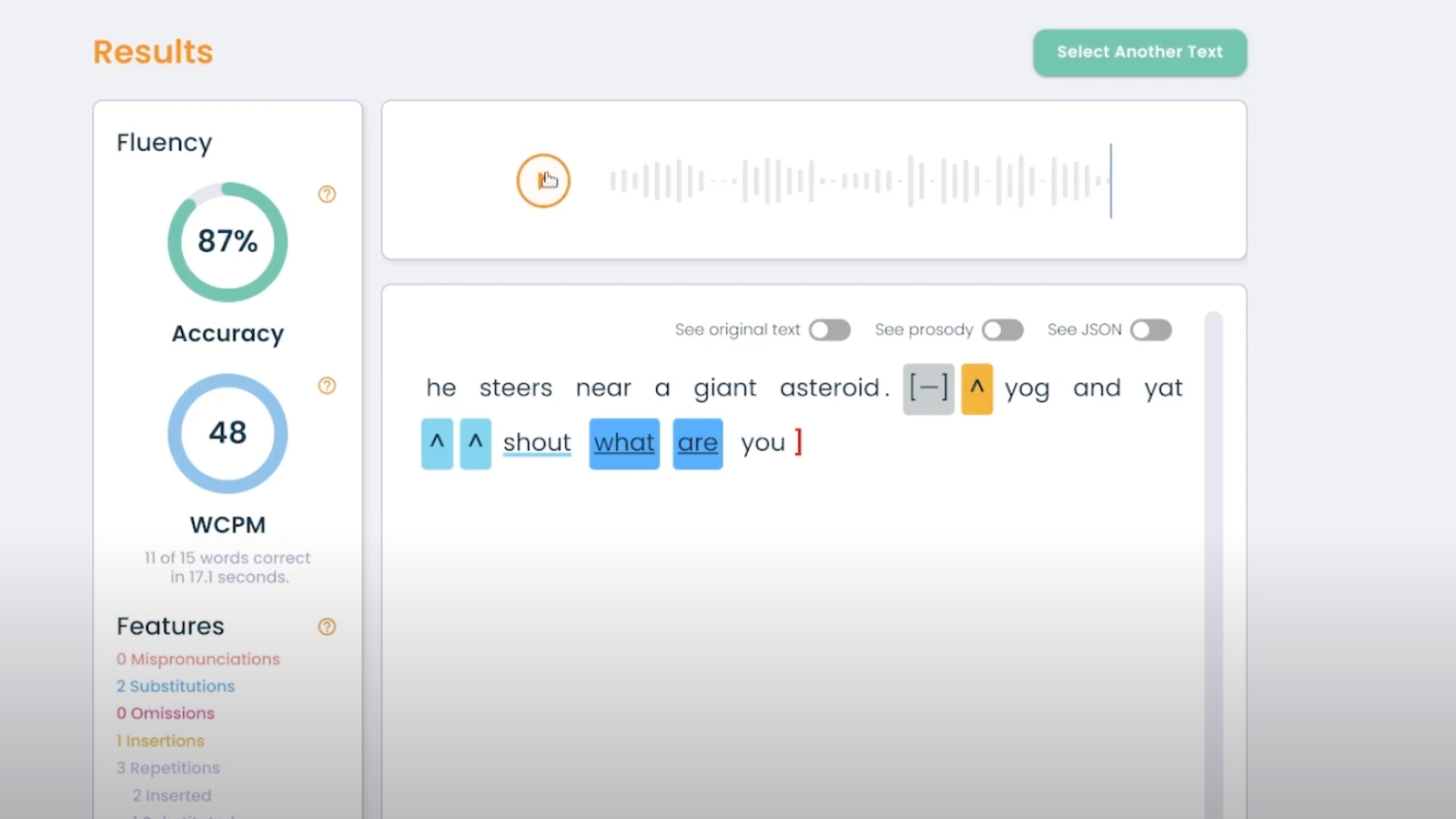The benefits of AI in the classroom for students and teachers
October 26, 2023

Imagine a third-grade classroom today. It hums with activity as kids settle down to reading a passage on their tablets. Notice how diverse this classroom is: the many different voices, ethnicities and sizes of kids in it.
Some read fluently, some more slowly as they struggle to pronounce new words or read longer sentences. In this swirl of activity, there is only one teacher trying to manage a full classroom and capture a sense of their students’ progress towards reading fluency.
The 21st century classroom is a quickly evolving space, where kids of multiple backgrounds, cultures, linguistic and learning abilities study together. The technology that caters to the modern classroom however, is still very much in the process of evolving to meet both the teacher and the students’ needs.
In its recent Global Monitoring Education Report, UNESCO called out the negative impacts of an “over-reliance” on edtech during the Covid-19 pandemic, saying that many of the edtech tools that replaced teachers exacerbated learning gaps between students.
Indeed, the report found that online-based learning during the pandemic was less about “discovery”, “exploration” or engagement for students, and more about sifting through monotonous and automated content. Not surprisingly, the result was a “disengagement” by students who felt that their lessons were talking at them, instead of helping them to learn.
The opportunity, as we reconstruct the post-pandemic, modern classroom is clear. Child-centric edtech tools must be engaging, equitable, authentically useful, and put the needs of a diverse set of learners and their teachers first. The technology used in the classrooms of the future must succeed in helping students find their voices in a way that acknowledges their unique starting point and learning path.

Here at SoapBox Labs, we understand the need to build personalized and inclusive technology for learning. SoapBox has spent over a decade building a voice engine that recognizes the huge variety in kids’ speech patterns, accents and speaking abilities. “When you recognize a child’s speech as being comprehensible and unique to them, you’re also inviting them to engage, to speak more, to build their confidence, to matter in the classroom,” says Brenda McGuirk, Head of Education Product at SoapBox Labs.
When you recognize a child’s speech as being comprehensible and unique to them, you’re also inviting them to engage, to speak more, to build their confidence, to matter in the classroom.
Brenda McGuirk, Head of Education Product at SoapBox Labs
SoapBox’s voice AI powers a range of early literacy and language learning tools, and can accurately understand the voices and utterances of kids, from the moment they start on their literacy and language learning journeys.
Renowned education organizations like McGraw Hill, Scholastic, Imagine Learning and EarlyBird develop voice-enabled learning tools that deliver on a range of promises – to support the teaching of phonics, to automate oral reading fluency assessments, to power screeners for earlier detection of dyslexia and ESL tools for kids to practice speaking English.
These tools, powered by SoapBox, are now used by teachers and students across 50 US states, thanks to the large footprint of our clients in school districts nationwide.
Why is voice-enabled learning becoming so popular, you ask? One reason is because it addresses the key challenge of a “silent” or passive interaction between students and the tech they use. Speaking aloud provides an immersive experience for learners of all ages, and research into early literacy development over the last 20+ years shows that when technology gives kids instant feedback, they learn at a faster pace.
Another reason for the growing popularity of voice-enabled tools is the granular data these tools return to teachers about the progress of individual students in their diverse classrooms. Voice-enabled assessments are frequent, invisible, authentic and automated, allowing teachers to pinpoint challenges earlier than before. Now, when a teacher sits down with an individual child or small group, they already know what areas to focus on, and what specific instruction to provide.

The modern classroom must embody equitable and inclusive learning as a fundamental building block of teaching and learning. It must favor thoughtful, unbiased and student-centered learning tools that help kids learn independently and at their own pace, and help teachers drive better outcomes through targeted instruction and more frequent, invisible assessments.
Puzzling pieces together
When the founder of SoapBox, Dr. Patricia Scanlon started the company, she knew that the speech recognition tools being built for adults would not work well for kids (remember those cute, early videos of toddlers trying to talk to Alexa?). Her vision was to create voice AI that catered specifically to kids’ unique voices and that supported them on that all important journey: from learning to read to reading to learn.
Kids have a wonderfully weird set of things they say. Their speech patterns are completely different from adults. They shout, whisper, and speak in a higher tone. Biologically, kids’ vocal chords just aren’t as developed as adults. Plus, the speech of a 4-year-old is totally different from that of a 6 or an 8-year-old. For voice AI tools trained on adult voices, accommodating these “other voices” is more than a challenge.
Let’s break it down further. Voice AI engines are only as good as the voice data that powers them. So, if the engine comes across words or speech patterns it doesn’t recognize, it will make mistakes and return incorrect analysis.
Now imagine these “mistakes” built into a voice-enabled literacy tool in a classroom: Kids who are strong readers getting low reading scores when they deserve higher ones, their confidence and academic performance being damaged in the immediate, and for the longer term.
At SoapBox, we have collected thousands of hours of kids’ speech data in order to build our language and acoustic models, and to ensure our engine caters to as diverse a range of accents and dialects as possible.
An accurate voice AI engine is the non-negotiable first step, but at SoapBox, we took it a step further.
No accuracy without diversity
Students in the same classroom have different accents and native languages. They also have diverse academic and socio-economic backgrounds. Classrooms are also inherently noisy learning environments, which further complicates the task of voice-enabled tools to listen and interpret individual children’s speech correctly.
SoapBox went to the root of these challenges and created all new datasets of student voices. And, in doing so, we have set a new standard for diversity and equity in building AI tools that actually work for kids.
SoapBox exposed our kid-specific voice AI engine to the greatest possible variety of sounds, utterances and accents, and to the voices of children from 192 countries, all speaking naturally in their noisy environments. Our data set is rich with all kinds of utterances because voice, accent and intonation are all culturally specific.
The job of mitigating bias in voice AI is never done, but training our AI datasets from day one is a good starting point.
SoapBox’s Chief Technology Officer, Amelia Kelly, explains why this kind of messy and expansive data set is needed to create an equitable voice AI engine.
“In traditional speech data collection, if children are asked to read a sentence written by a white person for example, each child is going to read in the General American English (GA) vernacular the white person wrote in,” Amelia explained. “This means children who naturally speak in African American English or Latino American English will code switch to GA.”
Acknowledging and removing the additional cognitive load of code switching is essential to equitable learning experiences for kids. Before being deployed in the classroom, voice AI must be proven to understand all kids, as they speak naturally, at home with friends and family. Here’s Amelia again, describing how SoapBox tests our voice engine’s accuracy across accents and dialects, using an approach called “Describe the Picture”.
Empowering educators and instruction
When equity is a design principle, the result is a voice-enabled experience where every child is understood. So, every child, regardless of their reading level or challenge, gets accurate and immediate feedback to encourage them to keep practicing and progressing their learning.
In a classroom full of third-graders, voice AI is the aide their teachers never had, the key to assessing each student’s reading level accurately and regularly.
A voice-enabled reading tool generates phoneme-level data about who’s struggling, where and how. And it captures nuances in each student’s learning process that the teacher would otherwise miss in a noisy or chaotic classroom.
For instance, if a student reads a sentence like “I met the president,” the voice-enabled reading tool is going to break each utterance in the sentence down to the phonemic level. If the student didn’t read the words correctly, or didn’t associate the right sound to the phoneme, the voice engine captures and feeds this back in real time to the student or, more often, directly to the teacher.
With voice-enabled learning tools, students don’t feel the pressure to “perform” in a test, they’re just interacting with a game-like interface, reading words and sentences aloud. Under the hood, however, the SoapBox voice engine is working hard to present a comprehensive view of the student’s reading level. For early literacy, how well the student decoded and blended letter sounds for example, and for older students, how many errors they made such as omissions, deletions, and substitutions.

With such accurate and personalized feedback, teachers can design specific human interventions for individual kids or small groups in their classes to accelerate skill acquisition even further.
The learning tools of the future
The classroom of the future is already here. For schools, teachers and edtech companies alike, the priority must be to find technology solutions that work in real-world classrooms, that are proven to be equitable, and that keep students safe.
For Scholastic’s K-3 learners, SoapBox is powering Reading4Reading, a supplemental phonics tool that can be used at home and in classrooms to enhance early literacy skills and help kids master reading through the agency of their own voice.
For EarlyBird Education, SoapBox’s voice engine powers an early screening tool to identify challenges like dyslexia, making intervention more specific and effective.
To cater to the needs of bilingual learners, SoapBox is building a Spanish language voice AI engine from the ground up, with support from the Bill and Melinda Gates Foundation. Bilingual speakers in the US are the fastest growing demographic in the US school system, and SoapBox recognizes that they too need to have the opportunity to use their natural voices and language to support their own learning processes.
Giving students a voice – literally – in their unique learning journey will equip them with the life skills they need to thrive.
Equitable and accurate voice AI isn’t a singular solution, but the voice-enabled learning tools it powers will ensure students, educators and schools have the kinds of learning experiences and data insights they need to help every child to fulfill their potential at school, and onwards in their lives.




